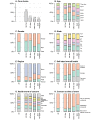Access, Use, and Patient-Reported Experiences of Emergency Care During the COVID-19 Pandemic: Population-Based Survey
- PMID: 34494967
- PMCID: PMC8428819
- DOI: 10.2196/30878
Access, Use, and Patient-Reported Experiences of Emergency Care During the COVID-19 Pandemic: Population-Based Survey
Abstract
Background: An increase in the number of people presenting to emergency departments (EDs) is contributing to ED overcrowding. In the early stages of the COVID-19 pandemic, there was a significant reduction in the number of ED presentations in Australia, creating an opportunity to learn from patients' experiences of alternative management options.
Objective: The aim of this study is to report on the use and experience of health services by Australian adults experiencing a health issue during the COVID-19 pandemic for which they would have presented at an ED prior to the pandemic.
Methods: An online survey was conducted in May 2020. Reported health issues were categorized using an existing classification system. Data collected included demographics, care pathways, levels of concern at times of health issue and survey completion, and patient-reported experiences with care.
Results: A total of 1289 eligible respondents completed the survey. Almost 25% (309/1289) of respondents avoided an ED presentation, of which 58% (179/309) used an alternative form of health care and 42% (130/309) self-managed. Respondents making face-to-face or telehealth appointments with their general practitioner (GP) reported high levels of ED avoidance (135/286, 47%) and mostly positive experiences of care provided by GPs. A high proportion of those who self-managed reported high levels of concern at the time of completing the survey (42/130, 32%).
Conclusions: Telehealth consultations with GPs may be a more promotable alternative to the ED beyond the COVID-19 pandemic, providing easier access to a doctor with access to patients' medical histories than an appointment for a face-to-face consultation. GP telehealth consultations may also address barriers to accessing health care for those with potentially the greatest need. The reported use and positive experiences with GP telehealth appointments should inform further research on their appropriateness as an alternative to the ED.
Keywords: COVID-19; ED avoidance; access; barrier; emergency department; emergency department avoidance; experience; patient-reported; survey; telehealth; telemedicine; usage.
©Jodi Gray, Andrew Partington, Jonathan Karnon. Originally published in JMIR Human Factors (https://humanfactors.jmir.org), 08.09.2021.
Conflict of interest statement
Conflicts of Interest: None declared.
Figures



Similar articles
-
People's Experiences and Satisfaction With Telehealth During the COVID-19 Pandemic in Australia: Cross-Sectional Survey Study.J Med Internet Res. 2020 Dec 10;22(12):e24531. doi: 10.2196/24531. J Med Internet Res. 2020. PMID: 33156806 Free PMC article.
-
Patient Use, Experience, and Satisfaction With Telehealth in an Australian Population (Reimagining Health Care): Web-Based Survey Study.J Med Internet Res. 2023 Aug 17;25:e45016. doi: 10.2196/45016. J Med Internet Res. 2023. PMID: 37590037 Free PMC article.
-
The experience of Australian general practice patients at high risk of poor health outcomes with telehealth during the COVID-19 pandemic: a qualitative study.BMC Fam Pract. 2021 Apr 8;22(1):69. doi: 10.1186/s12875-021-01408-w. BMC Fam Pract. 2021. PMID: 33832422 Free PMC article.
-
Association between telehealth use and general practitioner characteristics during COVID-19: findings from a nationally representative survey of Australian doctors.BMJ Open. 2021 Mar 24;11(3):e046857. doi: 10.1136/bmjopen-2020-046857. BMJ Open. 2021. PMID: 33762248 Free PMC article.
-
Interventions Intended to Alleviate Emergency Department Overcrowding: CADTH Horizon Scan [Internet].Ottawa (ON): Canadian Agency for Drugs and Technologies in Health; 2023 Oct. Report No.: EN0051. Ottawa (ON): Canadian Agency for Drugs and Technologies in Health; 2023 Oct. Report No.: EN0051. PMID: 38096347 Free Books & Documents. Review.
Cited by
-
Feasibility of Self-Performed Lung Ultrasound with Remote Teleguidance for Monitoring at Home COVID-19 Patients.Biomedicines. 2022 Oct 13;10(10):2569. doi: 10.3390/biomedicines10102569. Biomedicines. 2022. PMID: 36289831 Free PMC article.
-
Impact of the COVID-19 pandemic on emergency hospital cancer admissions in a UK region.BMC Cancer. 2022 Aug 4;22(1):850. doi: 10.1186/s12885-022-09932-3. BMC Cancer. 2022. PMID: 35927617 Free PMC article.
-
Social Determinants of Health and Patients' Technology Acceptance of Telehealth During the COVID-19 Pandemic: Pilot Survey.JMIR Hum Factors. 2023 Nov 7;10:e47982. doi: 10.2196/47982. JMIR Hum Factors. 2023. PMID: 37934556 Free PMC article.
References
-
- Australian Institute of Health and Welfare . Emergency department care 2018-19: Australian hospital statistics (Supplementary data tables: Table 2.1) Canberra, Australia: AIHW; 2019. [2021-02-12]. http://www.aihw.gov.au/getmedia/6f15c095-e669-428c-9cef-a887cb65f3b0/Eme... .
-
- Morley C, Unwin M, Peterson GM, Stankovich J, Kinsman L. Emergency department crowding: A systematic review of causes, consequences and solutions. PLoS One. 2018;13(8):e0203316. doi: 10.1371/journal.pone.0203316. https://dx.plos.org/10.1371/journal.pone.0203316 PONE-D-18-06823 - DOI - DOI - PMC - PubMed
-
- Minister for Health Hon Greg Hunt MP Medicare bulk billing rates continue to grow. [2021-06-01]. https://www.health.gov.au/ministers/the-hon-greg-hunt-mp/media/medicare-... .
-
- Kam AW, Chaudhry SG, Gunasekaran N, White AJ, Vukasovic M, Fung AT. Fewer presentations to metropolitan emergency departments during the COVID-19 pandemic. Med J Aust. 2020 Oct 18;213(8):370–371. doi: 10.5694/mja2.50769. http://europepmc.org/abstract/MED/32946589 - DOI - PMC - PubMed
LinkOut - more resources
Full Text Sources

